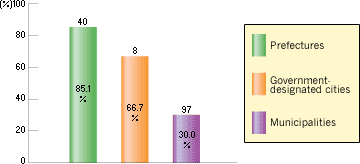![]()
Status of the Promotion of Gender Equality in Local Public Bodies
Local governments have been promoting measures that consider local circumstances and comply with national policies towards the realization of a gender-equal society.
They have also been pressing ahead with the enactment of ordinances on gender equality. Forty prefectures and ninety-seven municipalities have enacted ordinances (known to the Gender Equality Bureau as of December 27, 2002), and determined basic principles for gender equality.
Plans for gender equality have been formulated in all prefectures and government-designated cities. However, no more than 23.4% of municipalities had such plans.
Moreover, prefectures and government-designated cities have established administrative liaison conferences headed by their respective governors to facilitate the smooth promotion of measures to liaise and coordinate on related matters within their own organization under the leadership of their chiefs.
The average percentage of female members of advisory councils and committees stood at 24.6% in prefectures and 25.8% in government-designated cities, and the trend is for this to rise. Analysis of the percentage of female members of advisory councils and committees established in municipalities in accordance with laws, government ordinances or ordinances reveals that circumstances varied significantly. Although the overall average stood at 18.4%, female representation exceeded 30% in 110 municipalities, and seventeen towns and villages remained without a single female committee member.
Furthermore, the average percentage of women in managerial positions (positions equivalent to or higher than section chief in the central government) stood at 4.5% in prefectures and 5.9% in government-designated cities, and this is rising gradually. This ratio averaged at 7.0% in municipalities. However, whereas the ratio exceeded 10% in many local governments, 1,305 local governments, nearly half of the total number, remained without a single woman in a managerial position.
Women accounted for 6.8% of local assembly members, and this figure is rising slowly. However, more than half of town and village assemblies remained without single women members.
(Note) Unless specified otherwise, figures are correct as of April 1, 2002 (March 31 in some cases).
ENACTMENT OF ORDINANCES BY LOCAL GOVERNMENTS

(Notes)
- Percentages represent the ratio of all local governments in each category accounted for by those having enacted ordinances.
- Government-designated cities are not included in the number of municipalities.
Women's Conference Japan - Aomori 2002
The Women's Conference Japan was held in Aomori City, Aomori Prefecture on October 4 - 5 2002. The theme of this year's conference was "I think you are as important as I am."
More than 3000 individuals from around the country attended the conference. On October 4th, 13 workshops were held, and on October 5th plenary sessions and commemorative lectures were held at two venues. Several issues relating to gender equality were discussed from a variety of angles, and the necessity of aiming towards a society in which both women and men can live in harmony was reaffirmed.
In conclusion, an Appeal Statement resolving to build a society in which all persons are regarded as equal, regardless of sex, age or geographic location, and to realize a society in which each individual can live independently, was issued to the entire nation.
